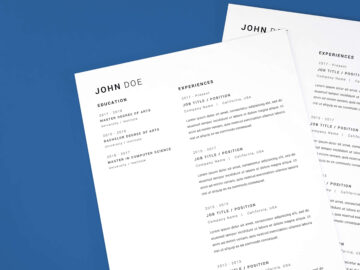First impressions count. This is especially true in the world of college and graduate school admissions, as both the number and competitiveness of applicants continue to increase. And what exactly is your first impression when applying to school? Your resume.
Now more than ever, it’s critical to have a resume that stands out at first glance. Yet many students make avoidable mistakes when crafting their CV (curriculum vitae, another phrase for resume), missing out on a chance to jump off the page and positioning themselves poorly for a competitive admissions process. Read on to learn how to craft a stellar resume and avoid getting lost in the shuffle.
Why A Great Resume Matters
Your CV is a living, breathing document. As you progress through college and into your career, you’ll update it continuously with new experiences and skills, accomplishments and awards.
But while the content of your CV will evolve as you do, its structure, layout and formatting should remain relatively constant. Why? The answer lies in a fundamental, and very common, misunderstanding about resumes.
The truth is how you tell your story matters as much, if not more, than what your story is.
Sure, you took challenging classes and volunteered on weekends. You’re the president of this club and a leader of that activity. That’s great, and very necessary to maximizing your odds of admission, but equally important is what kind of attitude and energy you brought to the table in each of those classes, activities and extracurriculars.
That’s what admissions committees really want to understand. Not just that you volunteered at the local homeless shelter, but that you showed up on time each day. That you remembered the directions your manager gave you without needing to be told twice. That you went above and beyond to complete each project, even if it exceeded your scope.
The way you convey those intangibles in an application, aside from letters of recommendation, is through the structure, layout and formatting of your resume. A clean structure, consistent layout and flawless formatting speak volumes. They show you’re the kind of person who pays attention to detail, who cares about doing the little things right.
The total number of college applications in the U.S. has ballooned from 5.4M the year before Covid-19 to 7.1M in this most recent cycle. With that level of competition, every minute detail counts. Here are some of the most common pitfalls students fall into when curating their resumes, and how to correct for them.
Common Missteps
-
Too long.
This one is easy. Your resume should be no longer than one page, full stop. Unless you have several decades of experience and are such a decorated thought leader in your field that you literally cannot capture all your magnificence on one page, this rule applies to you.
Play with formatting if you have to: shrink the margins (you can go tighter than the standard 1-inch, but ideally no smaller than 0.5-inches) or make the font smaller (no smaller than size 10 though – the admissions committees do need to be able to read what’s on there!). If you’re still struggling to squeeze everything onto a single page, meet with a mentor for help trimming it down. Odds are you’re holding on to experiences and facts that seem compelling to you but aren’t integral to your story.
-
Poor Layout
We’ve seen countless students mess this one up, and it’s the lowest of low hanging fruit. Admissions committees look at thousands of resumes, so it’s easy to toss aside those that fail to meet their standard of consistent layout and design.
For starters, each section should have the same number of bullets. Ideally three. Eight times out of ten this should be doable, but in some circumstances your experience may be sufficiently skewed that it just doesn’t make sense to have equal detail for each one. In those cases, it’s fine to deviate from this rule, but have a mentor or parent read it over and tell you what they glean from the page about your experience. If their summary isn’t what you want admissions officers to be thinking when they read your resume, try reworking the content.

Second, watch your margins and indentation. As mentioned above, it’s OK to slim down the page margins to 0.5-inches, but make sure you don’t push lower than that. Also double check that the left and right margins are equivalent. Experiences should be left-justified, dates should be right-justified, and supporting detail should be in bullet point format.
Lastly, use bolding and italics with purpose. Header sections can be bolded and underlined (i.e. Education, Professional Experience, Leadership, Activities and Awards), specific experiences can be bolded (i.e. Summer Intern, ABC Company) and subtext can be italicized (i.e. ABC Company is a technology firm specializing in…). Then the bullet points under each experience should be simple text. Feel free to play with the above guidelines – they’re just a starting point. But remember: when everything is highlighted, nothing is.
-
Poor Diction
The best academic and extracurricular track record won’t help much if the language you use to convey it is weak. Many students fall into passive voice when writing their resumes, often in an attempt to sound more professional or formal. Passive voice frames something else as the subject and you as the object: “Was tasked with creating a survey…” Instead, try to use active voice whenever possible: “Created a survey…”

Another best practice is to avoid starting sentences with gerunds (words that end in “-ing”) whenever possible. Sometimes breaking this rule is necessary, but more often than not there’s a way to rework the sentence such that you can start with a more forceful action verb.
Request a Mentor
Remember: a great resume is as much about how you tell your story as about what your story is. If you’re interested in working with Carnegie Prep’s highly qualified team to make sure your resume jumps off the page – in addition to the rest of your application – please take a few minutes to fill out the form at the link below.


